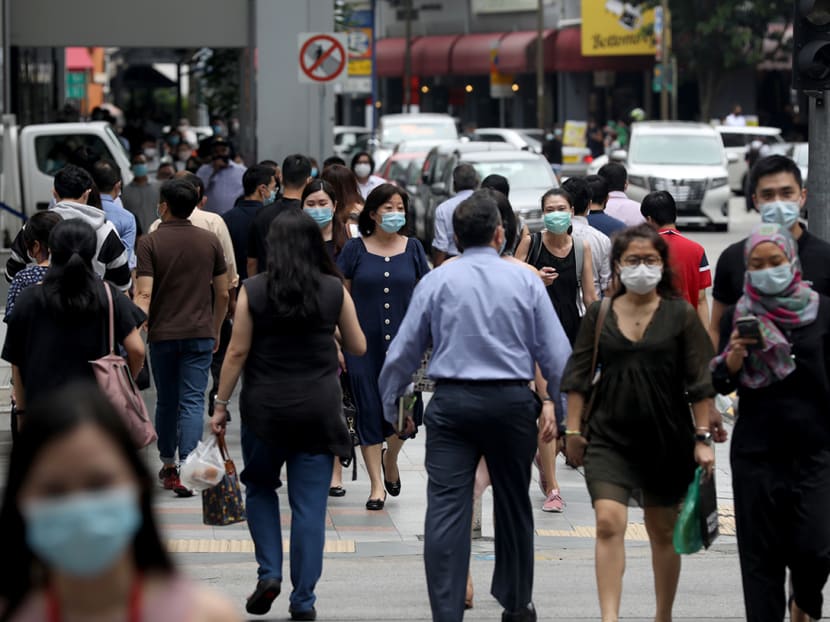Resident employment rises above pre-Covid-19 levels after job market rebounds in second half of 2020: MOM
SINGAPORE — Resident employment in Singapore rebounded to slightly above pre-Covid-19 levels at the end of 2020, as a strong recovery in the second half of the year boosted the number of employed residents by 14,900.

There were 2.37 million employed residents in Singapore at the end of 2020, slightly higher than the 2.36 million at the end of 2019.
- The total number of employed individuals in Singapore fell by 166,600 in 2020
- This is the sharpest contraction in more than 20 years
- The bulk of the decline was borne by foreign workers
- Resident employment rose by 14,900 to a level higher than before the pandemic
- But the unemployment rate is still higher than before the pandemic struck
SINGAPORE — Resident employment in Singapore rebounded to slightly above pre-Covid-19 levels at the end of 2020, as a strong recovery in the second half of the year boosted the number of employed residents by 14,900.
Released on Tuesday (March 16), the Ministry of Manpower’s 2020 labour market report showed that there were 2.37 million employed residents in Singapore at the end of last year, slightly higher than the 2.36 million at the end of 2019.
The growth in resident employment came after Singapore experienced its worst employment contraction in more than 20 years, with the total number of employed workers decreasing by 166,600 for the whole of 2020.
This is because non-resident workers bore the brunt of the employment decline.
Out of the 181,500 jobs lost among non-resident workers, the majority of them were work permit holders in the construction and manufacturing sector.
Speaking to the media, Manpower Minister Josephine Teo said that Singapore’s economy and labour market turned the corner in the fourth quarter of last year.
However, she cautioned that risks remain because borders are still not opening anytime soon and several government schemes assisting jobseekers will also taper off.
Here are the employment indicators at a glance.
EMPLOYMENT
For the fourth quarter of 2020:
Total employment contracted by 7,900, excluding foreign domestic workers
Non-resident employment decreased by 42,400, while resident employment went up by 34,500 — an increase for the second consecutive quarter
For the whole of 2020:
Total number of employed persons went down by 166,600, excluding foreign domestic workers
Number of employed workers who are non-residents fell by 181,500
Number of employed residents went up by 14,900
Total number of people employed in Singapore in December 2020: 3.36 million (excluding foreign domestic workers)
Total number of employed residents: 2.37 million
Non-residents made up 29.3 per cent of total employment in December 2020, down from 33.1 per cent a year before
Sectors that saw increases in resident employment were:
public administration and education
health and social services
information and communications
financial and insurance services
professional services
UNEMPLOYMENT
In December 2020:
Overall unemployment rate was 3.3 per cent (down from 3.5 per cent in September 2020)
Resident unemployment rate was 4.4 per cent (down from 4.8 per cent in September 2020)
Citizen unemployment rate was 4.5 per cent (down from 4.9 per cent in September 2020)
For the whole of 2020:
Overall unemployment rate was 3 per cent (up from 2.3 per cent in 2019)
Resident unemployment rate was 4.1 per cent (up from 3.1 per cent in 2019)
Citizen unemployment rate was 4.2 per cent (up from 3.3 per cent in 2019)
The unemployment rates did not exceed levels seen during the Global Financial Crisis in 2009 and the severe acute respiratory syndrome (Sars) outbreak in 2003, MOM said in its report.
RETRENCHMENT
For the fourth quarter of 2020:
Number of retrenchments was 5,640, a drop from 9,120 in the previous quarter
This is the first decline after five consecutive quarters of increases
Retrenchments dropped in all industries except for the air transport and related services sector
For the whole of 2020:
Number of retrenchments was 26,110, more than double the 10,690 retrenched in 2019
Total number retrenched was higher than the Global Financial Crisis in 2009 (23,430), but lower than after the bursting of the dot-com bubble in 2001 (27,570) and the Asian Financial Crisis in 1998 (32,800)
Annual incidence of retrenchment was 12.8, which is the number of people retrenched for every 1,000 individuals
Incidence of retrenchment was lower than during the Global Financial Crisis in 2009 (14,2), Sars outbreak in 2003 (16.7), dot-com bubble bursting in 2001 (26.3) and the Asian Financial Crisis in 1998 (32.7)
The highest retrenchments were seen in the services, wholesale trade, arts, entertainment and recreation, as well as air transport sectors
Age groups with largest retrenchments were people above 50 years old and those under 30
MOM also found that female workers were more prone to being retrenched than men, unlike in previous years. This is because females tend to be over-represented in sectors harder hit by Covid-19
MOM said in its report that residents working as clerical, sales and service employees were most prone to retrenchment last year because the Covid-19 pandemic had a bigger impact on industries that have a higher concentration of workers who were not categorised as professionals, managers, executives and technicians (PMETs).
Mrs Teo said that this was similar to the experience in other countries, where rank-and-file workers tended to be affected more negatively by the pandemic.
However, she noted that resident employment levels across all segments here, even among the rank and file, have gone up.
She acknowledged that these workers who managed to find a job after being laid off might not be in their preferred jobs.
“When we were dealing with this in 2020, it was more important to help them stay in the workforce than to force them to exit, which was the observation we found in other countries,” she said.
RE-ENTRY INTO WORKFORCE
For the fourth quarter of 2020:
The six-month re-entry rate, which refers to workers retrenched in the second quarter of 2020 and finding a job six months later, rose to 64 per cent. The rate was 57 per cent in the previous quarter
This means that a higher number of retrenched residents managed to find a job within six months
For the whole of 2020:
The annual re-entry rate dropped to 62 per cent, compared with 64 per cent in 2019. This rate refers to workers who were retrenched between the third quarter of 2019 and second quarter of 2020 and found a job by the end of the year
This means that retrenched residents took a longer time to secure another job within six months
MOM said that the decrease was seen across all occupational and educational groups, as well as most age groups, with the exception of those in their 50s
Most who found a job were able to switch industries
A relatively higher proportion took up jobs in the administration and support services sector, which suggested that temporary roles were being taken up, MOM said
The ministry's supplementary survey also found that among residents retrenched in the first half of 2020 and found work after, 48 per cent had pay cuts, especially among those aged 50 and above
When asked what MOM’s plans were to help those in temporary jobs borne out of the pandemic such as swabbers and safe-distancing ambassadors transit into more permanent roles once the outbreak subsides, Mrs Teo said that the number of job vacancies is going in the right direction, though not at pre-Covid levels yet.
The number of job vacancies rose to 56,500 in December last year, a high last seen in March 2019.
The ratio of job vacancies to unemployed individuals has improved from 0.63 in September 2020 to 0.77 in December 2020.
Mrs Teo said that with the economy reopening and new jobs being created, the ratio will continue to go up.








